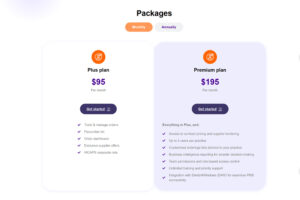Administrative workload in clinical procurement environments can be overwhelming. Managing orders, tracking shipments, liaising with suppliers, and reconciling deliveries often fall on busy staff already stretched across multiple responsibilities. Manual order follow-ups, delays, lost communication trails, and data fragmentation further complicate the process. Fortunately, the rise of end-to-end order tracking is transforming how clinics and practices manage their procurement workflows—drastically reducing admin overhead and enhancing operational control.
This blog explores how full-spectrum order tracking can streamline procurement and eliminate inefficiencies in administrative handling.
What Is End-to-End Order Tracking and Why Does It Matter?
End-to-end order tracking refers to the ability to monitor an order’s entire journey—from placement through supplier confirmation, dispatch, transit, and delivery—within a single platform. This level of visibility is crucial for eliminating guesswork and reducing the need for repetitive manual checks.
By having real-time insights into the procurement journey, practices can reduce miscommunication, administrative delays, and data loss across teams. A single view of order status allows for faster decisions, improved accountability, and a significant reduction in follow-up tasks.
Which Admin Pain Points Are Solved Through Full Order Visibility?
Clinics and healthcare businesses face several administrative pain points related to procurement, which end-to-end tracking directly addresses:
- Manual status checks with suppliers or couriers
- Duplicate communications due to unclear delivery timelines
- Fragmented record-keeping across spreadsheets, emails, and files
- Limited delivery accountability when issues arise
- Disorganised audit trails needed for compliance
- Inefficient reconciliation between ordered and delivered items
Through automation and visibility, each of these pain points can be either eliminated or significantly minimised.
How Does End-to-End Tracking Work in Practice?
The system enables seamless oversight from order initiation to delivery receipt. Here is a mapped example showing how the process eliminates specific admin burdens:
| System Step | Admin Burden Eliminated | Benefit / Outcome |
| Order placed via platform | Manual entry duplication and errors | Clean, structured data from the outset |
| Supplier confirms order | Time-consuming supplier confirmation | Digital acknowledgment visible in system |
| Dispatch update from supplier | Need for follow-up calls or emails | Automated status change to “Dispatched” |
| Transit visibility via tracking | Checking courier websites or portals | Centralised delivery updates |
| Exception alert triggered | Missed delays or delivery anomalies | Staff alerted automatically |
| Delivery confirmation | Manual confirmation and reconciliation | Auto-recorded status in order history |
| Inventory adjusted post-delivery | Spreadsheet updates or manual entry | Real-time inventory alignment |
| Budget updates linked | Cross-checking financial allocations | Automated reflection in budget modules |
| Staff-specific views enabled | Unnecessary access or confusion | Cleaner role-based tracking per user type |
This system is not only faster—it is more precise, controlled, and compliant.
What Features and Attributes Support Admin Efficiency?
A robust tracking system incorporates layered functionalities that drive time-saving benefits. Below are key attributes clinics and healthcare practices should look for when evaluating their procurement solutions:
- Real-time order status updates
- Exception alerts for delays or supplier issues
- Role-based access control and visibility
- Order approval workflows with live tracking
- Automated delivery confirmations
- Comprehensive order history and audit logs
- Inventory sync with delivery status
- Multi-site dashboard visibility
- Supplier integration for live updates
- Centralised reconciliation and reporting
These attributes are essential in converting time-consuming tasks into automatic flows that reduce human involvement without losing control or oversight.
What Semantic Benefits Can Clinics Expect?
Implementing end-to-end order tracking affects more than just processes. It has ripple effects across a clinic’s entire operational structure.
Key Improvements Include:
- Fewer administrative bottlenecks in procurement
- Reduced staff workload through automation
- Faster issue identification and response
- Enhanced communication between clinical and procurement teams
- Stronger audit and compliance readiness
- Greater visibility for practice managers and owners
- Smoother onboarding of new team members with standardised systems
It is not merely about technology—it is about liberating your admin team from micromanagement.
What Are the Broader Implications for Multi-Site Clinics?
For clinics operating across multiple locations, centralising order visibility becomes even more important. End-to-end tracking allows head office procurement managers to view order status across all sites, identify location-specific delivery issues, and streamline bulk purchasing across the network.
This enables:
- Centralised dashboards to compare statuses and supplier performance
- Aggregated reports for procurement trends
- Unified budgeting and forecasting
- Consistent record-keeping across clinics
- Faster scaling with standardised systems
How Can You Avoid Costly Order Mistakes and Delays?
Order errors are common in manual systems—wrong quantities, wrong delivery locations, or late orders due to miscommunication. These issues not only consume admin time but also disrupt clinical operations and affect patient service delivery.
By employing tracking systems that:
- Record every user action and supplier update
- Provide automated confirmation requests
- Trigger alerts when orders don’t meet expected timelines
- Offer centralised order reconciliation tools
—you mitigate most risks associated with delayed, missing or incorrect orders.
Why Is Restocq the Ideal Platform for Order Tracking in Healthcare?
Restocq offers purpose-built solutions for clinics, practices, and healthcare providers seeking better procurement control. With an intuitive dashboard, real-time order tracking, role-based access, and automated alerts, Restocq streamlines the order-to-delivery process like no other.
What sets Restocq apart is its deep understanding of the dental and clinical sector. From handling consumables to managing supplier variations, it ensures that clinics maintain transparency, reduce errors, and eliminate repetitive tasks for staff. Whether you’re a single-location dental surgery or a multi-site medical practice, Restocq scales with you—providing actionable insights, reducing procurement cycle time, and enhancing control at every stage.
By using Restocq, clinics no longer need to chase down deliveries, manually reconcile stock, or navigate a maze of emails and phone calls. Everything is visible, accountable, and optimised.
Explore how Restocq can simplify your workflow and liberate your team from unnecessary admin.
References
- Australian Commission on Safety and Quality in Health Care: Procurement and Supply Chain Considerations
https://www.safetyandquality.gov.au/ - Health Purchasing Victoria: Efficient Procurement in Healthcare
https://www.hpv.org.au/ - Department of Health and Aged Care – Supply Chain and Logistics
https://www.health.gov.au/initiatives-and-programs/supply-chain-logistics
Frequently Asked Questions (FAQs)
1. What is end-to-end order tracking in procurement?
End-to-end order tracking refers to monitoring an order’s complete journey from creation to final delivery, including supplier confirmations, dispatch status, and delivery verification—all in one platform.
2. How does order tracking reduce admin workload?
It eliminates manual follow-ups, provides real-time status updates, and automates reconciliation tasks, enabling staff to focus on higher-value responsibilities.
3. Can order tracking integrate with inventory and budget systems?
Yes. Restocq’s system updates inventory and budget data in real-time once deliveries are confirmed, ensuring seamless integration and accuracy.
4. What kind of alerts does an order tracking system provide?
It can send alerts for delivery delays, backorders, missing confirmations, and other exceptions, helping clinics respond proactively.
5. Is end-to-end tracking suitable for small practices?
Absolutely. Even small clinics benefit from automation, reduced errors, and better supplier visibility—without needing a large admin team.
6. How does role-based tracking improve workflow?
It ensures that each team member only sees orders relevant to their role, reducing confusion, improving clarity, and safeguarding data integrity.




